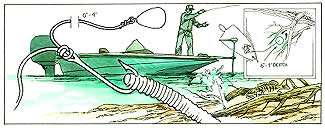
Wes Thomas lives in southern Indiana, where fishing waters can be seriously depleted by a herd of thirsty cows.
"We fish shallow waters," said the fishing pro from Hanover.
Making matters even more challenging, the shallow waters in his region are heavily pressured. Boats and bass fishermen line up just to get their own shot at a single piece of cover.
"We've got just 10 bass in southern Indiana," Thomas laughed "And we have to take our turn catching them."
According to Thomas, area bass fishermen know all about finesse fishing with downsized crankbaits and small spinnerbaits. While they've refined techniques for catching fish, sometimes simple finesse just isn't enough.
It was this intense pressure on shallow strike zones, ranging from 6 inches to only a few feet in depth, that forced Thomas to come up with an adaptation of the drop shot rig.
"We would be fishing a piece of cover, and we'd see a spot that we knew had to hold fish. We just knew there was a fish there, but we couldn't fish this spot with our normal techniques. There would be a fork in a laydown with a little brush around it in maybe a foot of water that just had to have a bass under it, but nothing we had in our arsenal would do the job.
"Spinnerbaits and crankbaits moved too fast, and so did jigs that would fall too fast through a small strike zone to trigger a strike. Then we came up with the idea of shortening the monofilament tail on a drop shot rig and putting on a soft plastic bait and twitching it right in the bass' face until it hit. It worked great," Thomas said.
While Thomas doesn't credit the short drop shot rig with any tournament wins, he says it's helped add weight in a number of tournaments he's fished. "It's a tool that I find works in the right conditions."
In fact, as this was being written, Thomas and his partner finished second in a tournament, mostly because of this modified drop shot rig.
"The tournament had 148 boats, and we placed second, losing only by a pound or so. We caught the only eight fish limit. In the area we fished, there were two other boats: One caught three fish, and the other caught five. We caught most of our fish on the drop shot rig."
The rig that Thomas ties is nothing but a standard drop shot rig tailored for shallow waters. First, he ties a Palomar knot on a hook and leaves a small tag. Instead of the 18 or 24 inches of tail on the knot, Thomas uses a tail as short as 6 inches to suit the cover and depth of water. He'll either nose hook the plastic bait or rig it Texas style.
While you can use just about any kind of weight, Thomas prefers one of the newer sinker designs intended for drop shot fishing — the kind with a wire eye that grips monofilament but slides off with a good, strong pull.
"In a tournament, I don't want to hang a sinker up that I have to break off or pull through brush and disturb fish. In one of our tournaments, if you have 8 pounds, you're in the Top 10. And if you have 10 pounds, you're challenging for the win. One fish can make a big difference."
Thomas says that the best time to use the rig is when shad and bass fry are balled up and visible. "The best time is when the fry are flipping on the surface."
He fishes the short rig on line weights up to 14-pound test, depending on the surrounding cover. Heavier line, he said, impedes the action of the soft plastic.
He likes small baits for this method and uses Yum Dingers in the 3-inch size and the 4-inch Yum Ribworm, Houdini Worm or one of the Yum Wooly baits, such as the smaller sizes of Hawgtail.
While Thomas and his partner started using the short drop shot rig around laydowns, he also throws it to shallow banks, where he'll walk it down the bank toward deeper water. Another spot is around bridge abutments where riprap leads into the creek channel. He throws the rig up into water as shallow as 6 inches and fishes it downhill to the channel edge, holding and stopping and jiggling the plastic bait until he gets bit.
Thomas says the rig isn't a silver bullet for tournament wins, but it will help catch fish when other techniques won't. And where ounces count, that's a good thing.




